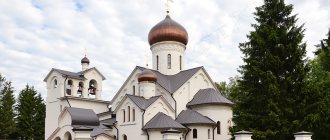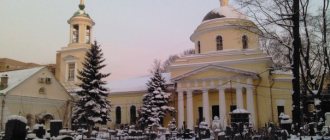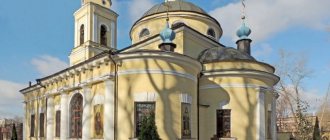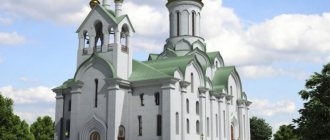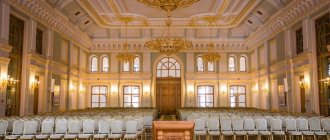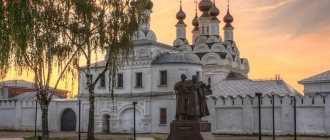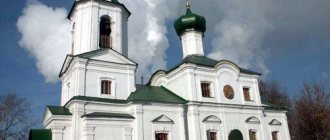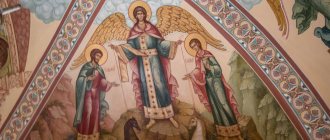| Moscow Trinity Church in Trinity-Golenishchevo, 2010. Photo from the site sobory.ru |
Moscow Church in the name of the Life-Giving Trinity in Trinity-Golenishchivo
- Address: Russia, 119285, Moscow, st. Mosfilmovskaya, 18A
- Directions: from the Kievskaya metro station by trolleybuses No. 17, 34, by bus No. 119 (the final stop is on the station square, near the clock tower) - to the Troitse-Golenischevo stop (9th from the Station). You can go to the same stop by trolleybus No. 34 from the Universitet or Yugo-Zapadnaya metro station, or by trolleybus No. 7 from the Kyiv or Oktyabrskaya metro station.
- Telephone.
- Official site:
- On the map: Yandex.Map, Google map
In the century, Metropolitan Gerontius built the Church of St. John the Evangelist in Golenishchev;
Later, a new wooden Trinity Church was built in its place, and the village of Golenishchevo received a double name - Trinity-Golenishchevo. The new stone Trinity Church was built on the site of the wooden one in 1644-1645. (according to other sources, even a little earlier), in an ancient patriarchal village on the Setun River. During this construction, the church was built with three altars: the main church in the name of the Holy Trinity, and two side chapels in the name of St. Jonah Metropolitan of Moscow and St. martyr Agapia.
At the same time, a stone patriarchal courtyard was built near it - the summer residence of the head of the Russian patriarch. Tsar Alexei Mikhailovich often came to the Sparrow Hills to hunt and attended services in the Trinity Church, if the patriarch himself served there. A garden was built to the south of the temple, and three fish ponds stretched near the palace and temple, which are still preserved. The palace has not survived; it was dismantled in the 19th century.
During the War of 1812, the church burned; Napoleonic soldiers set up a stable in it. The ancient iconostasis was destroyed in this fire, but the ancient icons were miraculously preserved - just before the start of the war, they were given for renewal to an icon painter who was able to preserve them. In 1815, the Trinity Church and St. John's chapel were restored and re-consecrated.
In 1860 a new bell tower was built. Restoration at the beginning of the twentieth century. did not deprive the temple of its former originality.
From 1924 to 1932, a sschmch served in the temple. Alexander Orlov (+ 1937).
In 1939, the temple was closed, the iconostasis was taken by director S. Eisenstein for the filming of the film “Ivan the Terrible”, and never returned to the temple. Where he disappeared is unknown. The antimensions of the chapels were moved to the neighboring Trinity Church in Vorobyovo, where a separate altar of Agapius and Jonah was built.
At various times, the church housed a village club, a Comintern radio station, then a cardboard factory, a factory of decorative secular candles, and, finally, a warehouse and music library of the USSR State Television and Radio Broadcasting Company.
In the 1970s There was no longer a warehouse in the temple, the building was empty and gradually fell into final decay. Later the temple was leased to the State Television and Radio Broadcasting Company.
In 1990, the process of transferring the temple to believers began, and on January 7, 1992, the first service was held there.
The Ionian Spring, located below the temple, on the river side, was cleared again. The church building has been almost completely restored.
Over the course of a year and a half, through the labors and donations of parishioners, a baptismal chapel was built near the Trinity Church. At the end of November 1999, the first sacraments of Baptism were performed there. Now everyone can receive Holy Baptism by immersing their heads in water three times.
| Moscow Trinity Church in Trinity-Golenishchevo, 2006. Photo by Prudnikova N.A. from temples.ru |
Temple architecture
The current Trinity Church was built according to the “drawing” of Antipa Konstantinov, who also built the Terem Palace in the Kremlin. Larion Mikhailovich Ushakov was taken as his assistant.
In plan, the church is quite close to the Church of the Intercession of the Virgin Mary in Medvedkovo - two chapels are adjacent on both sides at the level of the apse, and on the west and south the main volume is surrounded by a gallery. The symmetrical aisles are smaller copies of the main volume - they are also crowned with tents, although with a slightly different decor, and have separate apses. The southern aisle is dedicated to Jonah, Metropolitan of Moscow, the northern - to St. Martyr Agapius. The domes crowning the central tent and chapels are small, placed on narrow elegant drums, decorated with a barely noticeable openwork row of kokoshniks. Kokoshniki surround the chapel tents. There is no such decoration around the main tent: it is placed on a simpler octagon, and the quadrangle of the lower tier of the temple ends with keel-shaped zakomaras. The tents of the aisles and the main volume are also different. The central tent is smooth, lined with iron, and the side tents are decorated with rows of false dormer openings, giving them greater openwork and elegance than the main one. Unique for those times were the triangular pediments above the apses of the aisles.
The tented bell tower was built in 1860 instead of the “coeval” temple, also a dilapidated tented bell tower; the new one was moved slightly to the west - its predecessor was located in the north-western corner of the building. Then the chapel of St. Agapia was extended with a new refectory.
Trinity churches of old Moscow
In old Moscow there were many Trinity churches associated with outstanding deeds and names of Russian history. The Trinity church was the house church in the Sheremetev Hospice House (now the Sklifosovsky Research Institute of Emergency Medicine) and the temple in his Ostankino estate, which has survived to this day. In the name of the Life-Giving Trinity, one of the side churches in St. Basil's Cathedral on Red Square was consecrated. The main altars of many Moscow churches, known from their side chapels, are dedicated to the Holy Trinity, for example, in the Sergievskaya Church of Rogozhskaya Sloboda or in the St. Nicholas Church on Bersenevka.
The Feast of the Holy Trinity is celebrated on the fiftieth day after the Resurrection of Christ, hence another name for the holiday of this great church celebration - Pentecost. On this day the Descent of the Holy Spirit took place on the Apostles, and the foundation of the Church of Christ was laid.
The holiday is dedicated to the Holy Trinity, since the Descent of the Holy Spirit on the Apostles revealed the image of the Trinitarian God and the Divine salvation of the world: God the Father created the world, God the Son saved the human race through the Atonement, and God the Holy Spirit, emanating from the Father, sanctifies the world, overshadows the Church and bestows the understanding and power of Christian preaching throughout the world.
On this day, for the first time since Easter, worshipers in the temple again kneel.
Temple in the name of the Life-Giving Trinity on Vorobyovy Gory
One of the surviving and currently operating Trinity churches is hidden on Sparrow Hills - it is well known to visitors to the observation deck in front of the Main Building of Moscow State University and to passengers crossing the Moscow River on the metro bridge. This church turns white against the background of the dense crowns of the Sparrow Hills, like on a patterned carpet, especially in autumn, and in clear weather its small domes sparkle with gold - and it seems so tiny next to the giant university. More recently, there were proposals to give this temple to Moscow University as a house church - this is how they tried to protect the Moscow State University student theater within the walls of its own house church on Mokhovaya. And no one wondered how so many parishioners could fit within the walls of a small old church at the same celebration of Tatiana’s Day.
The Trinity Church has been connected throughout its life with the history of the ancient palace village of Vorobyovo. Its current building was built at the beginning of the 19th century, but the foundation of this church dates back to very early times in Moscow history. The village of Vorobyovo has been reliably known since 1451 or 1453, when Princess Sofya Vitovtovna, the wife of Moscow Grand Duke Vasily I, bought it from “Priest Sparrow” - it is believed that the name of the village and then the entire area “Sparrow Hills” came from the name of the priest. . Moscow legends interpret this name differently: as if dense cherry orchards grew here and therefore there were many sparrows pecking at the berries. Or simply the outlying mountains of Moscow - not mountains at all, but just hills, so small that they are “mountains” not for people, but for sparrows.
Since Vorobyovo was called a “village” from the very beginning of its appearance in the history of Moscow, this means that in those days there was already an Orthodox church here. It is possible that it was the Trinity Church that stood then in the village of Vorobyovo, which became the summer palace residence of the Moscow sovereign. Ivan the Terrible's father, Grand Duke Vasily III, fell in love with this beautiful place. Back in 1521, during the invasion of Mengli-Girey, he hid here, near the wooden palace he built, in a haystack, and remained unharmed. From Vorobyov, the Grand Duke often went hunting near Volokolamsk, and while hunting in the late autumn of 1533 he became dangerously ill. The cruelly suffering prince was brought to the Vorobyovsky Palace, where he lay for two days, waiting for a bridge to be built to cross him - the ice had not yet firmly bound the river. But when the horses harnessed to the sovereign’s cart stepped onto the erected bridge, it collapsed, and the rider was miraculously not injured. He did not have long to live - the sick prince was transported on a ferry near Dorogomilov and taken to the Kremlin, where he died the next day, December 3, 1533. His son, heir John, was not even 4 years old at the time.
And when Ivan Vasilyevich turned 17 years old, he retired to his father’s shelter during a terrible summer fire in Moscow in 1547. Thus, in the Vorobyovsky Palace, Ivan the Terrible experienced the first terrible days of his reign - only six months passed after his coronation to the Russian throne. The burning city was deserted, and the rebel people rushed here, to the royal palace, but were met with cannons. This event marked the beginning of the reign of the first Russian Tsar.
The Vorobyovsky Royal Palace lived a long life. Boris Godunov, Peter I, who ordered a birch grove to be planted in his garden, and Catherine the Great loved him, but by the end of her reign in the 1790s, the palace was dismantled due to its disrepair. And twenty years later, on the Sparrow Hills, the “crown of Moscow”, according to the figurative expression of Emperor Alexander I, the construction of the Cathedral of Christ the Savior according to the design of A. Vitberg began - their first “great construction”.
Trinity Church, which became one of the local palace churches, witnessed all these events. It was mentioned in 1644 as a very ancient church that had long stood in Vorobyovo. The fact is that along with it there were 2-3 more palace churches. One day they were all dismantled and in their place they built one Trinity Church with side altars. But the current church building, built only in 1811, has seen a lot in its lifetime. Already in 1812, M.I. himself prayed in it. Kutuzov before going to the military council in Fili. According to legend, this area has been associated with the Kutuzov family since ancient times. The village of Golenishchevo, neighboring Vorobyov, with another, also Trinity Church, in the area of modern Mosfilmovskaya Street, and from the 15th century became part of their old boyar surname - as if the Moscow Metropolitan Jonah healed the boyar Vasily Kutuzov there, and this miracle was depicted in one of the hallmarks local icon of the saint in the Trinity-Golenishchevsky Church. That is why the descendants of the healed boyar began to be called Kutuzov-Golenishchev.
And the Trinity Church in Vorobyovo survived even after Napoleon himself came here to look at the panorama of Moscow, which lay at the foot of the Vorobyovy Mountains. The completion of the construction of the Trinity Church is sometimes attributed to the famous “holy doctor” F. Haas, who took such care of the prisoners of the local transit prison, built from former barracks for construction workers of the Witberg Cathedral of Christ the Savior. He wanted the prisoners to be somehow assigned to this church, to have the opportunity to attend services and be cared for by its priests.
The Trinity Church, remote from the center, miraculously survived during Soviet times - although the Bolsheviks paid attention to the Sparrow Hills (somewhere here was the dacha of Lunacharsky himself, and then Khrushchev) and attached great importance to the urban planning plans of the new, socialist Moscow. It was none other than L.B. who proposed renaming the Sparrow Hills to Lenin Hills. Krasin in February 1924, after Lenin's death. He also gave the idea to erect a giant monument to the leader and build a palace in his name. These plans of Krasin later formed the basis for the idea of the Palace of Soviets, for which, by the way, Vorobyovy Gory was also proposed at one time.
And according to the notorious General Plan for the Socialist Reconstruction of Moscow in 1935, the Lenin Hills were the final, final part of the supposed main main thoroughfare of the new city - Ilyich Avenue, passing through the center of Moscow and the Palace of Soviets. According to the authors of the project, the Lenin Mountains became the main vacation spot for Muscovites. “Imagine a mass holiday in socialist Moscow, when tens of thousands of vacationing proletarians will walk along Ilyich Alley, rejoice on the fields of mass events, and relax on the water. The aerial cableway carries more and more Muscovites over the Moscow River to the green Lenin Mountains, from where a magical panorama of the new Moscow opens, no longer without the shiny copper dome b. Church of the Savior, but with a towering silhouette of metal, concrete and glass - the majestic building of the Palace of the Soviets,” wrote one enthusiastic apologist for the 1935 General Plan.
However, the Trinity Church not only survived socialist destruction, but was not even closed during Soviet times, so its ancient interior has been preserved. Moreover, after the well-known Bolshevik ban on bell ringing throughout Moscow, it was in the Vorobyov Trinity Church that bells continued to ring - since it was then located outside the administrative city limits. And Orthodox Muscovites secretly went “to the Lenin Mountains” to listen to the blessed ringing on this miraculously remaining reserved island of old Moscow. Once again, Trinity Church survived the construction of a high-rise building at Moscow State University in the late 1940s - early 1950s - and such construction usually spared no one or anything.
Church of the Life-Giving Trinity in Listy
Among other Moscow Trinity churches, the beautiful and slender Church of the Holy Trinity in Listy, on the corner of Sretenka and Sukharevskaya Square, is remarkable for its history. The temple on this site has been known since 1635, and its surviving building was built after 1661. Under Tsar Alexei Mikhailovich, a streltsy regiment was stationed here nearby, and from the Palace Order the tsar granted the streltsy 150 thousand bricks for the construction of the temple - for the capture and bringing of Stepan to Moscow Razin.
At the end of the 17th century, the Streltsy regiment was headed by L. Sukharev, in whose honor under Peter I the famous Sukharev Tower was erected nearby, because the Sukharevsky regiment remained faithful to the young tsar during the rebellion. In 1689, Peter granted the archers 700 rubles for the repair of the Trinity Church for the capture of the rebel Fyodor Shaklovity.
In Moscow, this temple was also famous for the fact that near it they sold the best bergamot tobacco in the city, which was made by the church sexton according to a special, unknown recipe. One day, the Frenchman Olivier came to Trubnaya Square to buy such exquisite tobacco and met there one of the Pegov brothers, also a passionate lover of bergamot tobacco. The acquaintance was a success, and soon Pegov acquired a plot of land on Trubnaya and opened the Hermitage restaurant, which was headed by the culinary specialist Olivier, the author of the famous salad. Moscow students annually celebrated their Tatiana Day in this favorite restaurant.
And another blue and white Trinity Church in Serebryaniki is located on small Yauzskaya Street between Solyanka and Kotelniki - right opposite the local “high-rise”. In the 17th century, there was a Money Court here, where the royal silver coins were minted and master silversmiths lived. This is where the name of the area comes from. The church appeared here even before the Romanovs, and in 1781 it was rebuilt by the famous Moscow architect K.I. Blank. It is interesting because in 1768 its bell tower was built at his own expense by the great-great-grandfather of Pushkin’s wife, Afanasy Goncharov, who had his own estate and linen factory nearby. In this bell tower, Goncharov built a small side church in the name of St. John the Baptist for the commemoration of parents. There is a version that the Goncharovskaya bell tower has survived to this day with some changes, while another believes that Blank dismantled the old bell tower and built a new, modern one. Previously, there was also a tower clock with chimes on it, that is, with chimes. It is also noteworthy that it was in this boiler room Trinity Church at the turn of the 19th – 20th centuries that electricity was first used to illuminate worship services: small electric light bulbs were installed in the church chandeliers.
Of the destroyed Trinity churches, we will remember the temple that had the old Moscow name on Kapelki, which stood on 1-Meshchanskaya Street (in Soviet times - Prospekt Mira). Legend has it that in the old days there was an ordinary Moscow tavern here - a circle courtyard, or, as they said in Moscow, a circle. The kisser, his owner, was a very pious man and decided to renovate the old local church - he began to ask each of his guests to pour a drop from his glass onto the temple. Peter heard about this and went to the kisser himself. He did not recognize the king and also asked him to drain a drop. The king asked him why he was asking this, and the old kisser answered him that he was collecting money for the church drop by drop. Peter donated money to him, and so the new Trinity Church on Kapelki appeared.
Historians explain this old Moscow toponym differently, since the church was called “what’s on Kaplya” back in 1625 - long before the birth of Tsar Peter I. According to scientific findings, the name came from the name of the local stream Koptelka, or from the small river Kaplya, a tributary the Naprudnaya River, which supplied water to the famous local ponds of the palace Naprudnaya Sloboda, where the surviving Trifonov Church was built in ancient times (see February 14).
It is interesting that Peter I actually took part in the fate of the Trinity Church on Meshchanskaya. In 1708, the old wooden church burned down, and by order of the tsar, a new one was erected in just 4 years - Empress Catherine herself, Peter’s wife, donated funds for it.
In 1931–1933, the Trinity Church on Kapelki was demolished and an ordinary residential building was built in its place.
Social activities
For several years, the parish of the Church of the Life-Giving Trinity in Troitsky-Golenishchev has been providing financial assistance to the social rehabilitation center for minors “Istok” located in the Smolensk region. From time to time, a car with clothes, shoes, stationery, food, etc. is sent to this orphanage from the parish. This summer, the parish helped the center organize a children's summer camp.
Responsible for social activities:
- Priest Alexey Merkishin Tel. Email
Parish life[edit]
a Sunday school at the church.
, in which children study the Law of God, liturgics, Church Slavonic language, church singing, music and drawing.
Spiritual and charitable service is carried out in a kindergarten in the neighboring village of Povedniki.
In military units No. 5583 and 23320, church clergy conduct weekly spiritual conversations with officers and conscripts.
In the boarding house M.O. located on the territory of the village of Troitskoye. “Podmoskovye” and the Red Cross sanatorium “Druzhba” the clergy regularly perform prayer services and conduct spiritual conversations with staff and vacationers.
Since 2000, the Temple, with the blessing of Metropolitan Juvenaly of Krutitsky and Kolomna, has been publishing its own newspaper “Troitsky Messenger”.
A charity canteen operates daily at the temple, where everyone eats and social and charitable services are gradually being established.
How to get there[edit]
Address:
Moscow region, Mytishchi district, village. Trinity. Trinity Church.
Directions:
- by car: along Dmitrovskoye Highway, after the village of Vinogradovo, follow the sign for the Golden City, Argo restaurant, at the traffic lights turn right, up to the sign for the Golden City, follow the sign turn left, keep to the main road, approximately 3 km.
- by bus: from the Altufyevo metro station, bus. 302 to finish.
Email:
